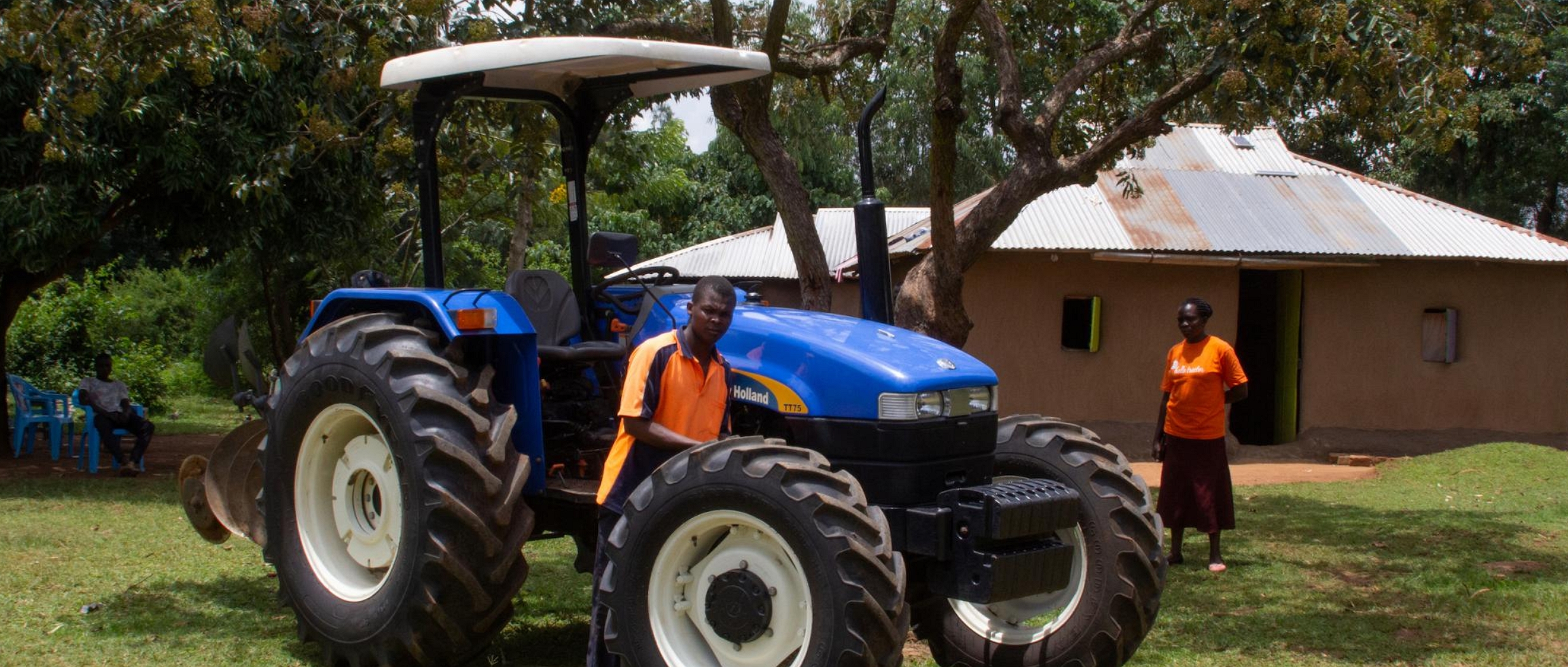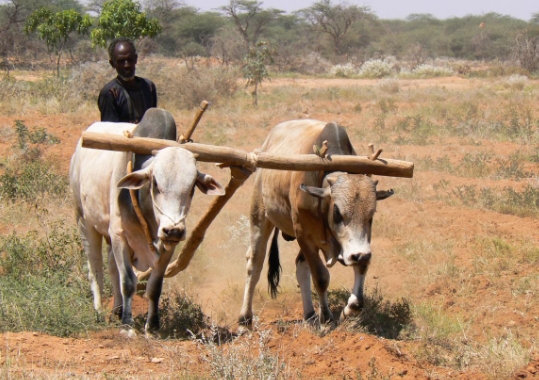Yields are low in many regions of Africa. Tractor plowing could help increase productivity
The tractor is in the middle of the lot, blue and shiny. From the front it looks almost as tall as the two adobe houses in the background with their corrugated iron roofs. The 75 hp colossus has belonged to Elder Marium since February. The farmer and her husband Sebastian Glay Okoth cultivate 1.2 hectares of land in western Kenya. The area on which the couple grows corn, sorghum and soybeans is not even the size of two soccer fields. The fields yield far too little profit to be able to pay for a tractor, and in fact the agricultural machine does not yet belong to Marium, she has incurred debts for it. The 42-year-old paid five million Kenyan shillings, the equivalent of a good 40,000 euros. For this she also got a plow and a “ripper”, an attachment for tilling the soil before sowing without a plough. The process is a method of “sustainable agriculture”: It is intended to reduce erosion, reduce CO2 emissions and preserve the soil structure.
When Marium talks about her tractor, it almost sounds as if she’s talking about a friend or at least a living being who has joined the family. “Since the tractor came,” she often says, instead of “since I got the tractor.” The startup “Hello Tractor” granted her a “pay-as-you-go” loan for the financing. “So I only have to pay back if the tractor is working and earning money for me,” says the farmer, explaining the financing model. And that’s exactly why she bought the tractor: so that it could earn money for her. Because the heavy machine is of course not fully utilized by plowing Marium’s 1.2 hectares twice a year before the rainy season – in Kenya there are two, provided the climate crisis does not change the annual rhythm again – to prepare the soil for sowing.
Other farmers can rent Marium’s tractor via the “Hello Tractor” app. She negotiates with them how much they pay per unit of area. At present, it usually charges 3,500 shillings per acre (0.4 hectares), around 30 euros. Depending on the condition of the soil, it sometimes demands more or less, because if the tractor doesn’t have to work quite as hard, it uses less diesel. The app is something like the driving service provider Uber for the field, supplemented by financing offers from the start-up for tractors.
Majority of the population lives in the countryside
Jehiel Oliver, who was trained in the USA, had the idea. “On the African continent, the majority of the population lives in rural areas,” he says, describing his considerations. In Nigeria, for example, more than 70 percent of the people work in agriculture. Nevertheless, the food produced is not sufficient to feed the entire population. Oliver looked for ways to change this situation.
This is mainly due to the fact that the harvest volume per unit area is not sufficient, says Christian Borgemeister, one of the directors of the Center for Development Research at the University of Bonn. “If you look at the global development of yields from important crops such as corn, wheat or rice, you will actually see a kind of linear increase in yields in all regions of the world. Just not in Africa,” he summarizes the problem. Where productivity has increased in African countries, it has been due to an increase in acreage at the expense of forests and savannas, not better yields per square meter, says the scientist.
Mechanization an important factor
Oliver wants to solve this central problem in African agriculture: the lack of the necessary machinery to cultivate the fields commercially and thus deliver better yields per square meter. In Kenya and many other countries on the continent, fields are still tilled with oxen ploughs, which is at least easier than manual labour. However, the shares of the oxen plow do not penetrate as deep into the soil as when working with the tractor. Oliver is aware that mechanization alone does not increase yields: “Another important factor is soil fertility, for example.” But he wanted to start somewhere to improve productivity and income in the countryside.
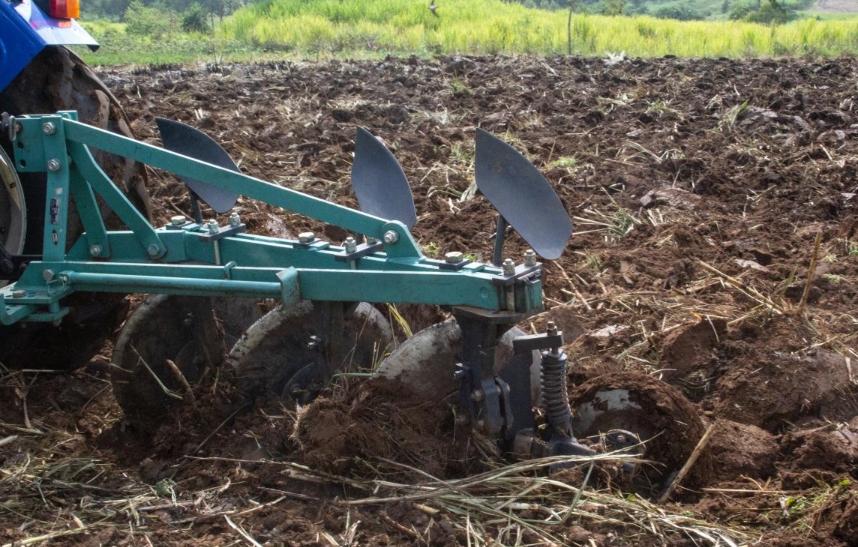
So, in 2015, Oliver founded the Hello Tractor app in Nigeria. He was fascinated by the challenges and opportunities offered by the West African country of more than 200 million people. According to the company, the app is now used in 13 African countries. Farmers use them to offer their tractors, plows or “rippers” for shared use. Around 3000 tractors with different implements are registered on the platform. According to Hello Tractor, in Kenya alone more than 40,000 farmers are now using the app to have their fields tilled. “In view of the demand, that’s still far too little,” emphasizes Oliver.
Competition desired
However, demand fluctuates by season and month, making it difficult to quantify monthly usage. In any case, “one company alone cannot bring the solution,” says Oliver. Instead, his team wants to “develop a concept with which tractor owners can successfully operate their fleet and serve small farmers”. The change that the company wants to achieve: More income for farmers, tractor owners and workers in the countryside. If the feasibility of the concept is confirmed, other banks and other financial institutions would show interest and help to solve capital bottlenecks. “We want to develop a solution that others can copy from us,” emphasizes Oliver. Competition is therefore expressly desired.
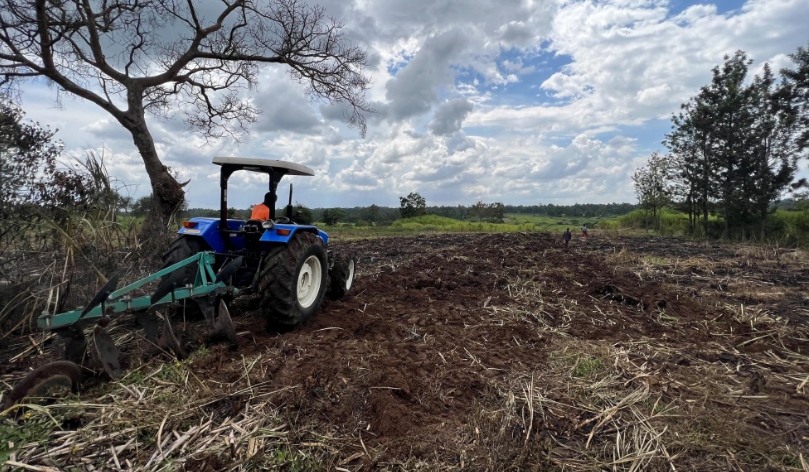
But the app is not accessible to everyone, not everyone has a smartphone. Tractors have been brokered in an analogue way for longer than “Hello Tractor”. Elder Marium was an agent for this before joining the digital provider. “It was much more complex than it is now with the app,” she describes. “I walked a long time or took a motorbike taxi to find enough farmers to make the tractor rental company’s journey worthwhile.” Despite the more time it took, she received a lower agency fee than later when she was hired out for “Hello Tractor”. Agents are also still needed for the digital platform, because not all farmers have a smartphone.
Bundling the need
Above all, however, the business model is only worthwhile for tractor owners if they have to work a larger area of fields in one place. “No one would travel 100 kilometers by tractor to plow half a hectare,” says Oliver, explaining the problem. But in Kenya, almost all agricultural land is small compared, for example, to the fields in Germany, where the average size of the fields in 2021 was 64 hectares, in Mecklenburg-Western Pomerania even 280 hectares. “98 percent of our customers till less than two hectares,” says Oliver. This is exactly where the app wants to come up with a solution: “The booking agents bundle the needs and ensure that there is enough work for the tractor when it comes.” After a few days of work, the next “cluster” continues. Because Kenya has different climatic zones, the demand does not end abruptly after a few weeks nationwide, but is somewhat staggered over time. Nevertheless, there is high and low season: Shortly before the rainy season, the tractors are booked a lot, in between it gets quieter. However, Oliver admits that very small and very remote areas remain inaccessible to mechanization.
For plowing, the farmers pay the tractor owners a certain sum per unit area. “Hello Tractor” gets five percent of this for mediation. The booking agent gets five percent if one was involved. And if the tractor was financed by a loan, Marium says 800 shillings per acre goes towards paying off the loan. Around 85 to 90 percent remain with the tractor owner. “I have to use this to pay for the diesel, the tractor driver and something for maintenance or repairs,” explains Marium. Most tractor owners do not drive their machine themselves, but employ an “operator”. Marium has two tractor drivers, one of them is Frederik Maina. Years ago, Maina trained as an agricultural machinery technician, while other “operators” learned car mechanics or at least acquired basic knowledge in the maintenance of tractors, plowing technology and the like in short further training courses. Marium pays him 300 shillings per acre, the equivalent of 2.50 euros.
“In September I didn’t make any profit at all,” says the entrepreneur. Nevertheless, she is not overly worried, not even given the almost 40,000 euros she still has to repay in credit. Because the monthly repayment rate depends on what the tractor has actually generated. If the order situation is poor, the installments are correspondingly low, and if the tractor just sits around for a while, the repayment is automatically suspended. Other tractor owners confirm that their income has also increased, but varies with the season. In fact, Rosaline Siama is so enthusiastic that she wants to buy a second tractor as soon as possible.
More income for tractor drivers
Frederik Maina, Elder Marium’s “operator,” is also happy. He has only been with Marium since September, standing in for another driver who is currently visiting family in central Kenya. Maina says he made 10,000 shillings in one month. That is twice as much as his previous income as an assistant to truck drivers. For Robert Okwara, Rosaline Siama’s ‘operator’, the pay gap from before is even bigger. His income also fluctuates greatly depending on the month. In September, a particularly good month for him, he earned 37,000 shillings, the equivalent of around 310 euros. And that in just two weeks, because in the other two weeks of September he did a training course at Hello Tractor, for which he did not have to pay anything. Okware did a tractor mechanic and driver course a few years ago and then worked as a seasonal tractor driver for the Kenyan government. There he earned 12,000 shillings a month, “but only two or three months a year”.
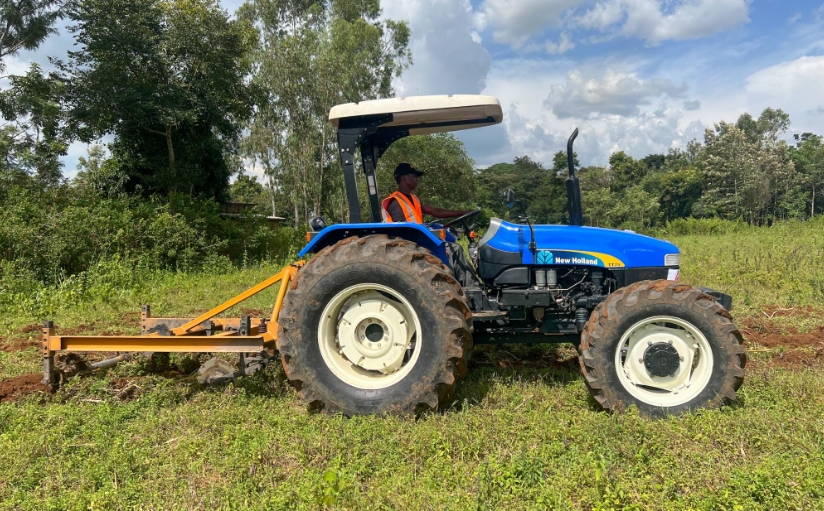
Farmer Genevive Mambo is also fundamentally impressed by the mechanization. The 67-year-old used to be a teacher and has been farming intensively since she retired. On her 1.6 hectares, she grows a variety of crops: “Corn, soybeans, sometimes rice, cassava, millet, sorghum, peanuts and vegetables.” Using the tractor has increased the corn yield significantly, says Mambo: “If I rented an ox plow, I would harvest five to six bags per acre,” she calculates. “After plowing with the tractor, there were at least 16.” Other farmers make similar statements: Thanks to more effective plowing with the tractor, the harvest has improved significantly, most speak of a doubling. And the costs have even gone down. The experience of Mambo, one of Marium’s customers, stands for many others: while the workers with the ox plow took three days to plow one acre, the tractor does the same area in 45 minutes. For the strenuous plowing with oxen, she had to employ several workers for three days, including cooking and paying. That was significantly more expensive than the 3,500 shillings per acre for field work with the machine.
Fewer jobs for day laborers
The downside of using a tractor, which obviously pays off for the farmer, the tractor driver and the owner: the agricultural day laborers in the area now have less work. For them it is therefore a blessing that the entire production cycle in Kenya has not yet been mechanized: Mambo and the other farmers in the region still employ workers for planting, weeding and harvesting. Marium also used to earn money on Mambo’s fields, since their own fields were not enough to generate enough for the family. Now the older one is Maria’s customer.
However, how sustainably the income situation improves is not only due to the level of mechanization. The climate crisis makes planting cycles unpredictable, floods and droughts lead to crop failures. The situation is particularly difficult at the moment because of the price increases, also as a result of the war in Ukraine. Not only diesel has become more expensive, but also fertilizer. In the last season she paid 2,500 shillings for 50 kilos, says Mambo. “Now the same amount costs 6800” – an increase of 172 percent. As a result, Mambo only tilled half of her fields, part of it with organic fertilizer. Due to the reduced area, she now only harvested as much as before the tractor was used. Despite this, she is not in need: so far she has harvested more than she needs and has given the surplus to relatives who live in a drier area and hardly harvest anything themselves. For them, however, it is now close.
Not a royal road, but a way
Despite everything, Francisco Marí is cautious about whether mechanization is the best way to increase living standards in rural areas. Marí is a consultant for nutrition and agricultural trade at the aid organization Bread for the World. The reports from Marium, Maina, Mambo and the others sound positive, he thinks. “But in the long term we have to get away from energy-intensive farm inputs.” “Hello Tractor” is aware of the problem. “We are already negotiating with suppliers of electric tractors,” says Kenneth Chege from the startup. “But these tractors are still far too expensive for our customers.” Added to this is the problem of frequent power failures, and reliable recharging is likely to be difficult at the moment. But at least it is recognized that next steps are necessary.
It is also important to him to continue to spread the more environmentally friendly “conservation agriculture”, says app founder Oliver. This is because the soil structure is less disturbed, the microorganisms are preserved and there is less risk of erosion. On the other hand, weeds are a more massive problem. “We advertise it, but most of our customers still want the classic plow.” That’s not the ideal solution, he says. “But doing nothing is not ideal either. We have to try to find a way that minimizes the impact on the environment while also producing enough calories to solve at least some of the nutritional problems in our region in the most responsible way possible.”

